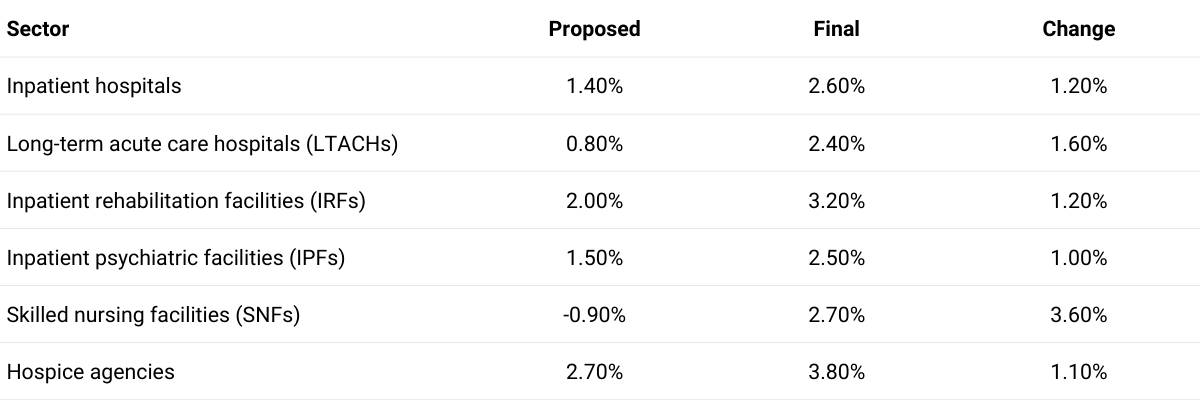
Inflation hits healthcare; CMS answers with higher 2023 Medicare rates
New Medicare rates reflect impact of rising inflation and shrinking labor pool—although not everyone benefitted equally.
After holding the line against inflationary pressures with little ability to increase prices, Medicare providers recently received some good news from the Centers for Medicare and Medicaid Services (CMS).
Under the recently finalized rates, all providers will receive pay bumps in 2023 with all finalized rates exceeding those proposed earlier this year. Leading the pack: skilled nursing facilities which will see a 3.6 percentage point increase over the 0.9% decrease initially proposed.
"Healthcare providers continue to face significant inflationary pressures and labor challenges," said Jason Almiro, senior vice president of healthcare banking at BOK Financial®. "In general, the finalized 2023 Medicare rates exceeded expectations and will accelerate the pace of the industry's recovery."
According to Almiro, CMS incorporated higher market basket rates—the list of items like drugs or medical supplies used to monitor inflation in the healthcare industry—of approximately 4% to compensate providers for rising labor costs and inflation, and capped future wage index decreases at 5% for many healthcare sectors (see table for a summary of proposed and final 2023 Medicare rate increases).
2023 Medicare reimbursement rates

- Inpatient hospitals: Payments to inpatient hospitals will grow by 2.6%, or $1.4 billion, in 2023, with for-profit hospitals seeing a 3.3% increase while not-for-profit hospital payments will rise only 2.5%. However, about 80% of all inpatient hospitals will be subject to readmissions penalties in 2023, and although CMS raised rates and operating payments, they decreased other payments. Uncompensated care and supplemental payments will decrease by about 3%, or $220 million, from 2022; Medicare-dependent and low-volume hospitals will also see reduced payments.
- Long-term acute care hospitals: Landing squarely in the column of "exceeds expectations," LTACH payments will increase by 2.4%, or $71 million, in 2023 compared to the original proposal of 0.8%. The 2023 standard payment rate will be $46,433, up from $44,713 for 2022.
- Inpatient rehabilitation facilities: IRF payments also came in higher than expected with a 3.2%, or $275 million, net increase; base rate payments will rise to $17,878 during 2023, up from $17,240 for 2022. IRFs may be subject to future reimbursement pressure, however, as CMS looks to add home health into the IRF transfer policy which could result in downward pressure on rates and payments in the future.
-
Inpatient psychiatric facilities: Reflecting recent data on labor costs and inflation, IPF payments will see a net increase of 2.5%, or $90 million in 2023. Free-standing, for-profit urban IPFs came in even higher with a 3.7% increase. However, there is some uncertainty about where rates might be going in the future.
"CMS recently analyzed IPF claims and found that changes to the codes, categories, factors, and payment amounts per treatment may, in their words, 'improve payment accuracy.' They're currently soliciting comments from stakeholders, but this exercise is concerning and may have a negative impact on future reimbursement rates," said Almiro.
-
Skilled nursing facilities: The biggest win was posted by SNFs, whose increase of 2.7%, or $904 million, significantly exceeded the proposed rate reduction. The sector also avoided a 4.6% one-time payment reduction stemming from the 2020 implementation of the Patient Driven Payment Model. The reduction will now be phased over two years, allowing SNFs to better manage cash flow.
The double shot of good news for SNFs will allow skilled nursing owners/operators to shift their focus to the minimum staffing requirement issues, a result of President Biden's call earlier this year to "increase quality and improve outcomes in nursing homes," according to Almiro. "CMS received more than 3,000 comments on the minimum staffing requirement issues. Most recognized the potential for increased quality and safety with minimum staffing levels while acknowledging challenges in recruiting and retaining, and funding the mandate," he said.
-
Hospice agencies: Hospice agency payments will rise 3.8%, or $825 million, with for-profit agencies coming in slightly ahead of not-for-profit counterparts at 3.9% and 3.7%, respectively. But, just as with other sectors, change could be on the horizon as CMS researches a new patient assessment instrument called Hospice Outcomes & Patient Evaluation (HOPE).
"This new tool is designed to better capture patient and family care needs," said Almiro. "And, although the agency isn't saying anything explicitly, Medicare rates may come under pressure with the implementation of HOPE in the near future."